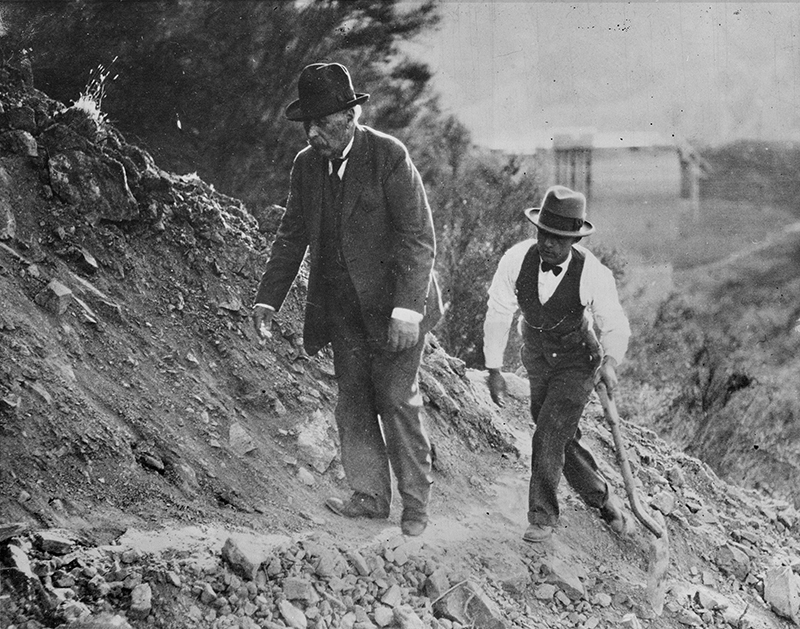|
|


Click image to enlarge
March 14, 1928 — Chief Engineer William Mulholland (left) tries to make sense of it all, one day and two nights after the St. Francis Dam failed, killing nearly 450 people. This haunting image was captured by photojournalist George Watson, who submitted it for publication to the Los Angeles Times. (The date, March 14, is noted in the Watson Archive card file for this image.) According to the file card, the man carrying the shovel is Mulholland's assistant, Harvey A. Van Norman. But St. Francis Dam historian Don Ray says it is George Vejar, Mulholland's chauffeur. Vejar "confirmed to me that it was him in this George Watson photo," Ray said (pers. comm. 2017). "Vejar told me that Mulholland often carried a shovel to use more as a cane." The original 4x5 negative, shot with a 4x5 Graflex camera, was donated to the J. Paul Getty Museum. This is the 4x5 copy negative from the Watson Archive. The image also appeared in the book about the Watson family of photographers, "Quick, Watson, the Camera: Seventy-Five Years of News Photography, Los Angeles" (Delmar Watson ed., 1975).
It can be fairly said that William Mulholland engineered the growth of Los Angeles, for he brought to it the one commodity this dusty, thirsty pueblo would need to support the influx of millions of new residents — water. Chief engineer for the city of Los Angeles Department of Water and Power, Mulholland was a key player in the construction of the Panama Canal, the Colorado Aqueduct, Hoover Dam and the Los Angeles Aqueduct — the latter taking water from the farmland of the Owens Valley and piping it to the growing metropolis. As part of the project, Mulholland designed and oversaw construction of the St. Francis Dam, a 600-foot-long, 185-foot-high curved, concrete gravity dam capable of holding 38,000 acre-feet (12.5 billion gallons) of water high above Saugus in San Francisquito Canyon. The reservoir would meet the needs of Los Angeles for about a year, should the Owens Valley farmers, who often sabotaged the project — or the Elizabeth Tunnel, which crossed the San Andreas fault to the north of the dam and "Powerhouse No. 1" — threaten the flow of water to the City. Dam construction started in August 1924; water began to fill the reservoir on March 1, 1926. Two months later the dam was completed. Mulholland's empire came crashing down at three minutes before midnight on March 12, 1928. Half of the dam suddenly collapsed. An immense wall of water rushed down the canyon at 18 miles per hour, totally decimating the concete-and-steel "Powerhouse No. 2" pumping station as well as the Frank LeBrun Ranch, the Harry Carey Ranch and Trading Post, and everything else that stood in the way. Floodwaters met the Santa Clara River at Castaic Junction and headed west toward the Pacific Ocean. The communities of Piru, Fillmore, Santa Paula, Saticoy and much of Ventura lay in waste by the time the water, mud and debris completed a 54-mile journey to the ocean at 5:25 a.m. on March 13th. At dawn's early light, an estimated 431 people lay dead (Stansell 2014). Some bodies were buried under several feet of earth and were still being discovered in the 1950s. In fact, remains believed to belong to a dam victim were found in 1994. Several investigations followed, including a hastily prepared government study released five days after the disaster, which attributed the failure to the construction of the west abutment on top of the fault contact between the Sespe conglomerate and the Pelona Shist. Later study discounted the theory and revealed that the east abutment was situated on top of an ancient paleo mega-landslide — something Mulholland did not know. (Perhaps he should have known; a report by geologist Dr. Bailey Willis, published June 25, 1928, three months after the dam failure, mentioned the ancient landslide.) Contributing factors may have been the base of the dam, which may not have been as thick as thought, and the top of the dam, where 15 feet of concrete were added that apparently were not in the engineering plans. The disaster that ended the career of the famous engineer was the second-worst in California history, behind only the great San Francisco earthquake and fire of 1906 in terms of lives lost.
LW3084: 9600 dpi jpeg from 4x5 copy negative purchased 2017 by Leon Worden from the Watson Archive.
|
SEE ALSO:
Transcript of Coroner's Inquest
Hall of Justice 1928
Verdict of Coroner's Jury
Arizona Report 1928
Popular Science 1964
• Rippens Story of Dam Disaster (1998)
Vital Lesson for Today (ASDSO 2018)
At Dam Site 3-14-1928
With Van Norman at Dam Site 3-15-1928
Coroner's Jury Inspects 3/1928
Hall of Justice 1928
Fountain 1940s
Aqueduct Memorial Garden Opens at Mulholland Fountain: Story 10-23-2013
Mulholland Fountain & Aqueduct Garden: Photo Gallery 11-10-2013
|
The site owner makes no assertions as to ownership of any original copyrights to digitized images. However, these images are intended for Personal or Research use only. Any other kind of use, including but not limited to commercial or scholarly publication in any medium or format, public exhibition, or use online or in a web site, may be subject to additional restrictions including but not limited to the copyrights held by parties other than the site owner. USERS ARE SOLELY RESPONSIBLE for determining the existence of such rights and for obtaining any permissions and/or paying associated fees necessary for the proposed use.















